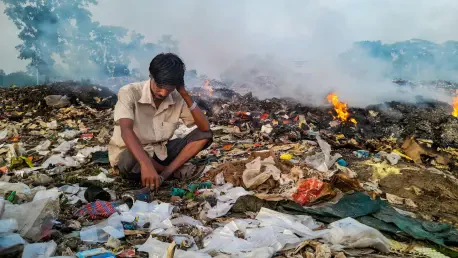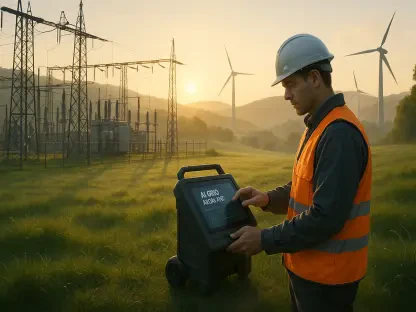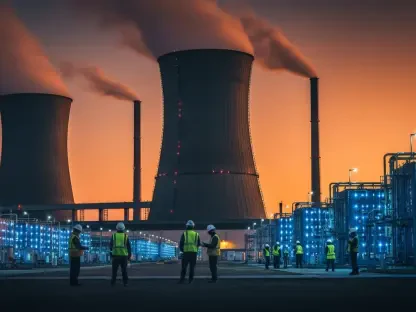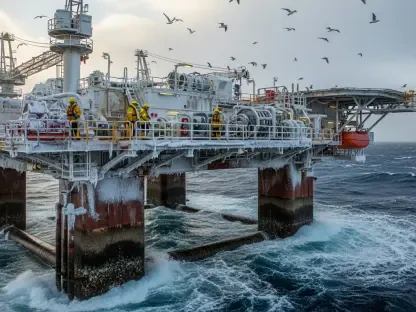Bangladesh finds itself at a critical crossroads as a severe power crisis looms large, casting a shadow over its ambitious economic aspirations and energy security, with approximately 65% of its power supply tied to imported fossil fuels in the fiscal year 2024-25. The nation is increasingly exposed to the whims of global market volatility and supply chain disruptions. This dependency often forces drastic measures, such as load-shedding during peak demand periods, disrupting daily life and industrial output. As the country prepares to graduate from least developed country (LDC) status by November 2026, the urgency to address these deep-rooted issues in the power sector has never been greater. The stakes are high, with energy stability directly linked to maintaining international competitiveness and supporting sustained growth.
Unpacking the Root Causes
Fossil Fuel Reliance and Market Vulnerabilities
The cornerstone of Bangladesh’s energy woes lies in its heavy dependence on imported fossil fuels, which make up a staggering 65% of the power supply for the fiscal year 2024-25. This reliance has left the country vulnerable to unpredictable swings in global fuel prices and supply interruptions, creating a fragile energy landscape. A stark example unfolded in early September this year, when fuel supply disruptions triggered an average shortfall of 404 megawatts (MW) during peak demand hours. Such incidents not only highlight the precarious nature of the current system but also underscore the financial strain of resorting to emergency measures like activating expensive oil-fired plants to bridge the gap. The ripple effects are felt across households and industries, where power cuts disrupt productivity and inflate operational costs.
Compounding this issue is the escalating challenge of gas supply shortages, which have directly impacted an increasing number of power plants. Between August 31 and September 11 this year, the number of affected plants rose from 12 to 19, exacerbating the supply-demand mismatch. This situation forces a reliance on less efficient and costlier alternatives, draining national resources and pushing up electricity tariffs. Beyond immediate financial burdens, these shortages expose systemic weaknesses in planning and infrastructure, revealing a critical need for diversification away from imported fuels. Without addressing this core vulnerability, the power sector remains at the mercy of external shocks, threatening long-term economic stability as global energy markets grow increasingly volatile.
Systemic Inefficiencies in Power Generation
Capacity vs. Reliability Challenges
Despite notable strides in expanding installed power generation capacity, Bangladesh struggles with a persistent gap between potential and actual supply reliability. Fuel shortages frequently render efficient gas-fired plants idle, pushing the system to depend on less effective and more expensive alternatives. This mismatch not only drives up costs through capacity payments—financial obligations for unused power infrastructure—but also risks long-term technical damage to critical equipment due to irregular operation. The inefficiency of this approach is evident in the frequent need for load-shedding, which disrupts both residential life and industrial operations. Addressing this disconnect requires a strategic overhaul to ensure that capacity translates into consistent, reliable output without wasteful expenditure or infrastructure strain.
Moreover, the reliance on suboptimal power sources during shortages highlights a deeper issue of resource allocation within the energy sector. When modern, efficient plants sit unused due to a lack of fuel, while older, less efficient oil-based systems are activated, the overall cost of electricity production skyrockets. This not only burdens the national budget but also erodes public trust in the power system’s ability to meet growing demand. The situation calls for better forecasting and fuel supply chain management to prevent such inefficiencies. Without tackling these operational challenges, the benefits of expanded capacity remain largely theoretical, leaving the nation vulnerable to recurring crises during peak demand periods.
Captive Power Generation Concerns
Industrial reliance on captive power generation adds a complex layer to Bangladesh’s energy challenges, often exacerbating inefficiencies across the system. While some industries have made progress in enhancing the efficiency of these independent power setups between 2012 and 2024, many continue to operate outdated, resource-intensive systems. These inefficient setups divert valuable gas supplies away from modern, grid-connected plants, inflating overall energy consumption and costs. This practice not only strains limited fuel resources but also undermines efforts to streamline power distribution through a centralized grid, creating a fragmented energy landscape that hinders systemic improvements.
Additionally, the persistence of substandard captive systems reflects a broader policy dilemma about balancing industrial autonomy with national energy goals. The continued use of such setups often results in higher operational costs for industries and contributes to environmental degradation through wasteful practices. Estimates suggest that modernizing these systems and harnessing waste heat could save billions of cubic feet of imported liquefied natural gas (LNG), easing the pressure on foreign exchange reserves. Resolving this issue demands clear guidelines and incentives to encourage industries to either upgrade their captive units or transition toward grid reliance, ensuring a more cohesive and sustainable energy framework for the future.
Charting a Path Forward
Energy Efficiency as a Solution
One of the most promising avenues for alleviating Bangladesh’s power sector woes lies in prioritizing energy efficiency and conservation. The government has already initiated measures, such as mandating energy audits for 189 large consumers starting this year and issuing guidelines to cap air conditioner settings at 25 degrees Celsius in households. These steps aim to curb wasteful consumption and set a precedent for responsible energy use. However, scaling up these efforts through the widespread adoption of energy management systems among industries and commercial buildings could yield even greater impact. According to the International Energy Agency (IEA), such systems can reduce energy use by 11% in the first year, with some companies achieving savings as high as 30%, demonstrating their potential to transform consumption patterns.
Beyond initial savings, energy management systems offer a structured approach to identifying inefficiencies and implementing lasting solutions. By conducting systematic reviews of energy use, businesses can pinpoint areas for improvement, monitor progress, and sustain reductions over time. Support from multilateral agencies through bodies like the Sustainable and Renewable Energy Development Authority (SREDA) could facilitate technical assistance and funding to accelerate adoption. These initiatives not only alleviate pressure on the power grid but also lower operational costs for large consumers, fostering a culture of sustainability. Embracing such strategies is essential to bridge the gap between rising demand and constrained supply, providing a buffer against external fuel market shocks.
Future Demand and Economic Pressures
Looking ahead, Bangladesh faces a daunting surge in power demand driven by rising global temperatures and robust economic recovery, particularly projected for 2026. This increase, coupled with the nation’s upcoming graduation from LDC status, places immense pressure on the power sector to deliver reliable, affordable energy to sustain industrial growth and international competitiveness. The economic implications are profound, as energy stability directly influences foreign investment and export capabilities. Without a resilient system, the country risks falling behind in a global market increasingly focused on efficiency and sustainability, making proactive measures to bolster the energy framework an urgent priority.
Furthermore, the reliance on dollar-denominated energy imports amplifies financial vulnerabilities, especially as global fuel prices remain unpredictable. Reducing exposure to these markets through domestic energy solutions and efficiency gains is critical to safeguarding the economy. The anticipated demand spike also underscores the need for infrastructure investments that prioritize long-term resilience over short-term fixes. Integrating renewable energy sources and enhancing grid reliability can help mitigate the risks of supply disruptions while supporting environmental goals. As economic activity intensifies, aligning energy policies with these broader objectives will be key to navigating the challenges of growth and transition.
Policy Dilemmas and Modernization Needs
A pivotal debate shaping Bangladesh’s energy future centers on the role of captive power versus grid reliance, highlighting the need for modernization and clear policy direction. Modernizing captive power systems, particularly through waste heat recovery, could save substantial amounts of imported LNG, easing the strain on national resources. However, many industries still cling to inefficient setups, draining gas supplies that could otherwise power more efficient grid-connected plants. The government faces a critical choice: enforce stricter efficiency standards for captive generators or incentivize a shift toward grid dependence, using captive systems solely as backups. This decision will shape the balance between industrial needs and systemic energy goals.
Equally important is the push to integrate renewable energy into the grid as part of a broader modernization effort. Transitioning industries to rely on a robust, centralized grid—supported by solar, wind, and other sustainable sources—offers a path to long-term stability and reduced import dependency. Such a shift requires substantial investment in infrastructure and policy frameworks that encourage renewable adoption while ensuring grid reliability during peak loads. Historical efforts to improve captive efficiency showed progress, yet the recurring fuel crises of recent months remind policymakers of the urgent need for systemic reform. Reflecting on past challenges, the focus must now shift to actionable strategies that prioritize sustainable growth and energy security for the decades ahead.









